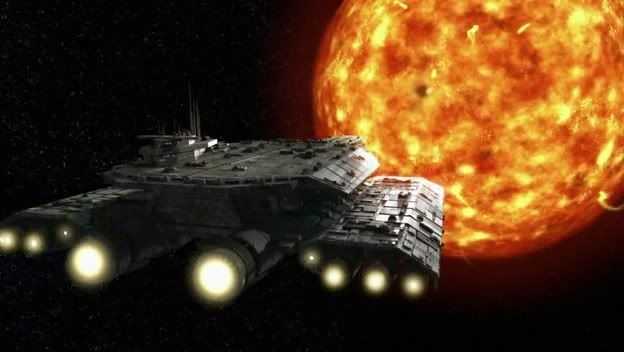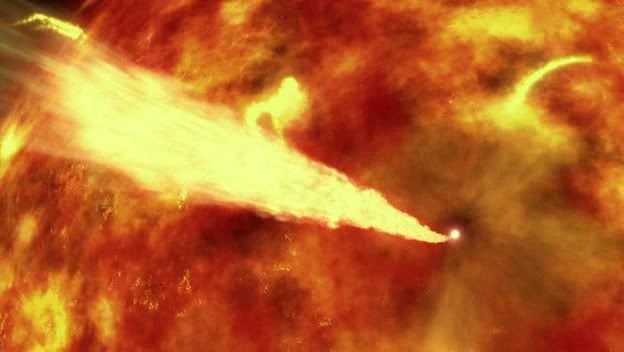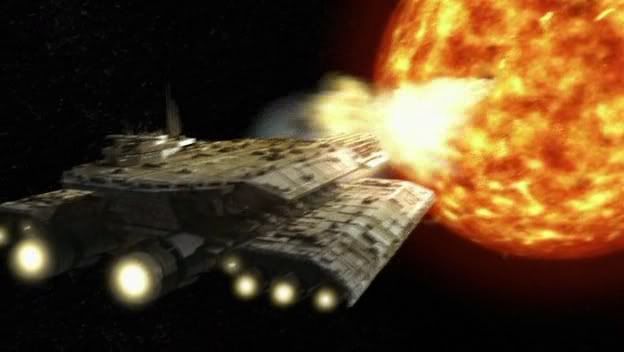Based on the previous agreement that the simply impossible visuals should be ignored in that case, let's run calcs just like we had ben reading a book, that is, solely based on dialogue, and eventually any other description - which may be visual mind you - but not directly tied to the uber CME visuals.
First, let's link to this interesting thread from spacebattles.com:
http://forums.spacebattles.com/showthread.php?t=110656
A couple of comments.
First, Akaviri assumed that we could take the level of rems spotted on Moon's surface, during the CME incident of 1972, and consider that at an altitude of 50 km above Earth, sufficiently out of most of the atmosphere, the level of radiations would have been the same.
I agree with the assumption, since the moon ir orbiting Earth, the obvious average distance "Sol <-> Luna" is going to be "Sol <-> Terra".
Later on, an issue was raised about how long it took for the blast to reach Lantia.
It's not clear which blast they're talking about. Obviously, the stream travelling at 4000 km/s couldn't touch the planet within +8 minutes. However, the EM radiations could.
So it's obviously been dissociated.
Above all, for the episode to make any sense, really, even with visuals out, we have to assume that the CME started as not being bigger than the 304, otherwise, no matter where the 304 was placed, most of the radiations would have hit Lantia.
I'll repost bits of the script, and outline elements of importance.
SHEPPARD: Adaris is a ship we found in the Ancient database.
McKAY: It’s an Ancient science vessel. About fifteen thousand years ago, it ran into some trouble. The entire crew was killed except for the pilot.
WEIR: The burned man. Teyla noticed the uniform. He was an Ancient pilot.
McKAY: Which would explain the burns.
ZELENKA: What does?
SHEPPARD: The ship got hit by a blast of radiation from the sun.
McKAY: It’s a coronal mass ejection on a scale that dwarfs anything our sun has ever emitted. Apparently the sun in this solar system goes through an unusually turbulent sunspot cycle every fifteen thousand years or so. The Ancients have records of this class of CME occurring twice before.
SHEPPARD: The ship was very close to the sun when it happened.
McKAY: It’s a massive prominence. It arced up and then collapsed when the magnetic field surrounding it weakened. We’re talking an intense proton stream travelling at over four thousand kilometres per second.
SHEPPARD: Most of the crew was killed instantly but the pilot managed to open up a hyperspace window just as they were hit. He flew the ship back here, jumping ahead of the radiation wave just in time to warn everyone.
McKAY: The Ancients were able to raise the shield and extend it far enough to protect a large portion of the planet from the blast.
WEIR: So what are you telling me? This is going to happen soon?
McKAY: Not soon. It’s happening right now.
(He turns the screen of his laptop towards her. It shows a prominence curling out from the edge of the sun.)
A few points to clear up.
First, the
science vessel Adaris was hit by the CME while it was close to the sun. Though most of the crew was killed, some of them survived long enough, like the pilot, to make a quick hyperspace jump back to Atlantis (maybe the jump was also boosted up by the same effects which propelled O'neill, Jacob, the rest of SG-1 and Apophis millions of lightyears away from the Vorash system, during the supernova... but to a minor extent). What's impressive is that the ship wasn't completely destroyed at this point.
It's an impressive feature, for again, a science vessel, especially since the crew was caught off guard.
We may even assert that shields were down, or not necessarily fully active.
Secondly, as we already know, that CME was a proton stream travelling at 4,000 km/s.
Well, stream is a funny word considering that it's much more like a spray than anything else. Or a wave.
This CME is supposed to dwarf anything our sun has emitted.
CONTROL ROOM. The image of the coronal prominence is now on a large screen.
McKAY: The magnetic field around it is already beginning to weaken. When that prominence collapses, the coronal mass ejection will occur. It’ll erupt from a very small area – a mere pinprick in comparison to the total sun’s surface, but it’ll immediately begin to fan out. Within a few million miles, the blast wave will cut a swathe wide enough to take out this entire planet.
SHEPPARD: How much time do we have?
ZELENKA: The prominence will collapse any moment now. After that, we have less than an hour before the radiation wave hits us.
SHEPPARD: Whatever. What are our options?
McKAY: Well, the Ancients were able to raise the shield and stretch it wide enough to protect a significant portion of the planet – attenuated, to be sure, more of a thin bubble, but it was able to block out enough of the radiation ...
ZELENKA: That’s interesting, because we have found evidence of mass extinction on other parts of the planet.
McKAY: Wow! Well, now we know what caused it(!)
WEIR: OK, so our shield is already activated. What else?
McKAY: Ah. Small problem. The Ancients had three ZedPMs at their disposal and we – as you know – only have one. Maybe I was so insistent on keeping them because I too am able to sense trouble on the horizon.
SHEPPARD: Just like a pigeon.
WEIR: So we just need to get the other two ZeePMs back here temporarily ...
McKAY: Not enough time. Look, the Odyssey’s away from Earth. In the time it would take them to return, the blast wave would almost certainly have hit us.
SHEPPARD: How far can we extend the shield with one ZeePM?
ZELENKA: Well, enough to cover the city and perhaps a little bit of the ocean surrounding it, but ...
SHEPPARD: We should evacuate, just to make sure.
McKAY: We can’t gate to Earth. Look, we need the ZedPM’s power for the shields.
SHEPPARD: We’ve got the intergalactic Bridge.
McKAY: The midway station isn’t completed yet. We’d need to ferry people by Jumper. Again, no time.
SHEPPARD: Alright – we’ll send everyone to the Alpha Site and pick ‘em up when this is over.
McKAY: I don’t think you understand. Look, the shield will protect the city from the initial blast, yes, but the entire ecosystem of this planet will be damaged beyond recovery for hundreds of years. Look, we’re talking no plant life, which means no breathable air ...
(Elizabeth faints, dropping to the floor.)
The ecosystem damaged beyond recovery for hundred of years. Yes, that's mass extinction everywhere there's not a shield to block the wave.
So it's, a least, still a total of many hundreds of teratons of energy hitting the parts which aren't even protected.
CONTROL ROOM. Radek is looking at the wall screen which shows that the whales are clustering as close to the city as they can.
ZELENKA: Look at them! Seeking shelter under the umbrella of the city.
McKAY (working on a laptop nearby): No-no-no-no-no-no-no. We don’t have nearly enough power. Look, we can extend the shield twenty kilometres beyond the city, maybe. But it’ll be dangerously thin and there’s no way of knowing whether we can sustain it, especially in a radiation blast of fifty thousand rem.
They're talking about the effects on the planet.
Obviously, he means the dose of radiations at shield altitude, that is, almost sea level, as what a human would get when placed on top of the shield, or located in a spot of the city that wouldn't offer any protection, if the case the shield wasn't up. Say on one of the piers, for example.
The difference between both positions is negligible anyway, since it's only a difference of height which is not meaningful because of how small it is.
If other elements have to be considered, like the figure being relative to a person located under the shield, and even possibly inside the city, then the initial rem would even be ludicrously higher. So let's not go there.
The radiations were likely of the type found in CMEs from our sun. The lantian sun doesn't seem to be different, at least in terms of temperature. Plus it's a yellow star.
Since the rem value is a global indicator, and meant for an average human body, basically the Moon value from 1972 can be directly related to Rodney's example, since they're all humans.
Dismissing the rem values because there would be no human is rather illogical, considering that obviously, any rem value will only be indicated in case humans are concerned.
And humans there were in Atlantis.
But contrarily to Akaviri, I won't use a factor between both rem figures.
Now, this is where it gets really alien to me, but before even attempting big equations, let's lay down the basics.
1 Sv = 100 rem, and 1 Sv = 1 gray = 1 J/kg.
Since Rodney mentionned a dose of 50,000 rems, then I suppose we're talking about 500 J/Kg.
Does get lethal when nearing 5 rem. Above, you're sure as hell to be dead. They would have been 10,000 times deader than dead, if they had been hit.
The average human height is 1.6 m.
"The average weight value for males is between 168 and 183 pounds (76-83 kg). [...] For females, the average weight in adults is 54-64 kg (12-140 pounds). These are considered in the normal range."
1
So let's get an average of all those values to get the approximative weight of some sort of half male half female human.
That's roughly 69.25 Kg.
The
Dubois BSA calculator provides, for a human of 69 Kg and a height of 1.6 m, the following BSA:
1.7215 m²
The total amount of joules for such a human would be roughly 69 x 500, thus 34,500 Joules.
________________
Before I continue on this road, without really knowing if it's a correct method, or at least rough enough to get some kind of idea about the powers at play, let me say that there are other elements I don't know what to with, but there really seems to be something at reach. If only we kno whow to compose the puzzle.
There's the radiation weighting factor, I don't know if we need it. It's based on two elements, a quality factor Q, depending on the type of radiations, and another factor N. N was equal to 1 when humans were concerned. It seems to have been ditched out of the meaning of radiation weighting factor.
The stream was composed of protons. They have a corresponding Q factor of 5.
________________
Resuming...
So our hybrid sort of human would have a body surface area of 1.7215 m², and would be throughly infused with 34.5 kilojoues.
Let's try to obtain an intensity there.
It wasn't sure if I had to divide the BSA by two, as it's traditionally done, for example, for spheres life surfaces which only side is facing a source of energy.
It's possible that I
should divide it by 2, since the whole body is supposed to be radiated. This would lead to slightly bigger numbers, as the intensity would increase (twice less BSA for the same energy, that's a bigger intensity).
So let's say it's conservative.
I get an intensity of I = 20.04 KJ/m².
Let's use the inverse square law here. I'm not sure about the initial area of the CME there, but we'll at least, get an idea about the initial power.
I'll assume a distance of 1 AU, since all parameters seem relatively similar to the duo Earth - Sol.
1 AU = 150 e6 km
I = P / 4 x pi x r²
P = I x 4 x pi x r²
P = 20040 x 4 x pi x (150 e9)
P = 5666.17651 e24 J (yottajoules)
P = 1354.2487 PT
P = 1.354 ET (exatons).
Surprisingly, they're not too far from Akaviri's calcs when he used the kinetic energies, and he made a couple of assumptions and admitted that the numbers may be one or more orders of magnitude off.
Now, this could be a dose per second.
Other elements I don't get, is just why Akaviri simply didn't make the calc by using Echoes' stream speed of 4000 km/s, instead of a Sol's typical CME speed. There was no reason to limit the calcs to 2000 km/s.
As for Necronlord, I really don't get the point of his attitude, and why he was so hellbent on dismissing the rem figure, and denying the simple pure fact that the frontal arc of the Daedalus' shield did start to glow before it was hit, and kept glowing long after the stream has been deflected... though this is arguing visuals, and at this point, I pretty much ignore them as a whole.
But
he was basing his claims on visuals, actually encouraged other people to watch the video as he did, yet did a poor job understanding the most simple phenomenom, up to the point where it was nothing more than trolling.
He also had a problem with the simple fact that Rodney was very worried about the heat, and invented lousy theories to explain why the hull was not being damaged because of extreme heat, especially the parts facing the sun and closer to the point of impact, but were only degrading because of internal heat build do the shields generators generating too much heat around them. Sure man, sure!
He simply invented stuff. At that point, someone needed to post a picture of the front arc glowing and flashing yellow after the stream's gone, to shut his big gapping mouth once and for all.
However, despite the asinine claims, we agree on the idea that the entire planet should have been in the shadow cast by the 304 intercepting the stream (and no, that doesn't mean that the city should have been stuck in a temporary night time, aka an eclipse, since the rest of the sun was not masked from Atlantis by the 304 - how could it be anyway??).
No matter how close to the sun the 304 would have been, it could have never blocked the entirety of the stream to prevent the planet from being partially hit.
Technically, the 304 should have expanded its shield to something as large as the planet itself, to be sure, and this couldn't have been possible, since the Lantians couldn't even protect the facing hemisphere with 3 ZPMS (showing how the shield is very unefficient when it comes to stretching it beyond its naturally designed surface).
See, while the stream is self expanding, obviously, any object placed even inside the stream (it wouldn't block the whole stream) would still cast a cone shaped dead angle, a shadow.
However, when it comes to radiations, it's not a punctual affair. Every square meter of the initial burst will radiate energy omnidirectionally, which means that I can't see how the 304 could have blocked the whole pack of radiations without literally coming with some sort of umbrella as wide as it would need to be to stretched edge to edge to the truncaturated cone formed by the edges of Earth (facing diameter being the smaller base, the tip of the cut cone) to the edge of the hyperactive spot at the surface of the photosphere (the largest cone's base, which diameter is that of the assumedly circular sun spot).
Now, if someone finds a way to explain how the stream remained that tight... from absurdingly powerful magnetic fields to some kind of black hole corridor that guided the stream, or a corridor of particles which managed to "tug" the super energized ions...
There's just no way a CME that already starts as wide as a planet, can shrink to the size of a 304... or there's some kind of weird phenomenom where there particles are pulling themselves towards each other, despite the energy and expected expansion... and then I wonder how such a thing could technically burst...
The site lists all SOHO spotted CMEs.
Some of them have angular width of two degrees, but they're rare.
It's simply way faster to claim that it's the result of some magical power, and that this CME is nothing natural, but triggered by something that's inside the sun, or some entity. Something.



